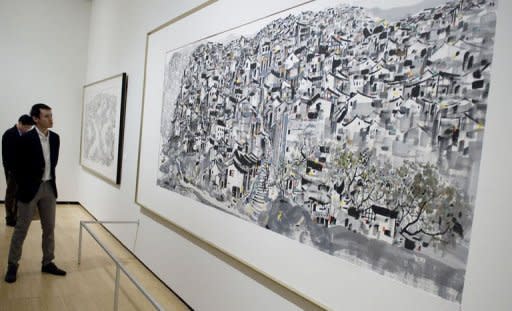Major US exhibit opens for Chinese artist Wu
The first major US retrospective of Chinese artist Wu Guanzhong opens Wednesday in New York, fulfilling the painter's dying wish to be better known in the West -- and signaling the continued rise of Chinese art on the international stage. Wu, whose 1919-2010 life spanned nearly all of China's tumultuous 20th century and rise as a world power in the 21st, had previously been shown in Europe but never in a serious way in the United States. Officials from Shanghai, where the Shanghai Art Museum houses much of Wu's work, on Tuesday also used a preview of the exhibition at the Asia Society in Manhattan to announce a major expansion of museum space this October, underlining the energy being put into China's art presence. In fact, Wu's story mirrors much of China's modern relationship with art and the outside world. Although he eventually became one of China's most celebrated painters, breathing new life into traditional ink techniques, Wu long struggled to gain recognition in the West while suffering persecution at home. "Most importantly, he wanted to be appreciated and recognized from the Western point of view and perspective," said Wu's son, Wu Keyu, his remarks translated into fluent English by Wu's grandson. "This opportunity here, I think, is really the kind of platform that I think he himself wants to showcase his works." Wu said at the preview that his father suffered banishment and obscurity in the Cultural Revolution, but was also lucky to live "when China started to open its doors, especially to the Western world." Works of his went from being "worth nothing to something that's worth millions of dollars today." The exhibition, set to run through August 5, focuses on Wu's ink works, which are unusually large and bright. "He ran counter to what all the other artists in China were interested in," Melissa Chiu, the Asia Society museum director, said at the preview. "He really did reenergize this traditional medium." Chiu indicated that the arrival of the Wu exhibit in New York reflected a new relationship between Western and Chinese curators. "For a long time, American museums have worked in such a way where we borrow objects. We control the curatorial, really produce the exhibitions ourselves," she said. Now Chinese museums want to be equal partners, she said, and "this was truly a partnership." The Shanghai Art Museum is to open new premises on October 1 in the building previously used as the China Pavilion in the World Expo, Shanghai 2010, making it one of the largest such institutions in the country. An entirely new Shanghai Contemporary Art Center will be opened at the same time in a former electrical power plant. "I think more and more an internationalized metropolis must be living under continuous development of culture," Teng Jungjie, artistic director of the Shanghai Municipal Culture Administration, said.




